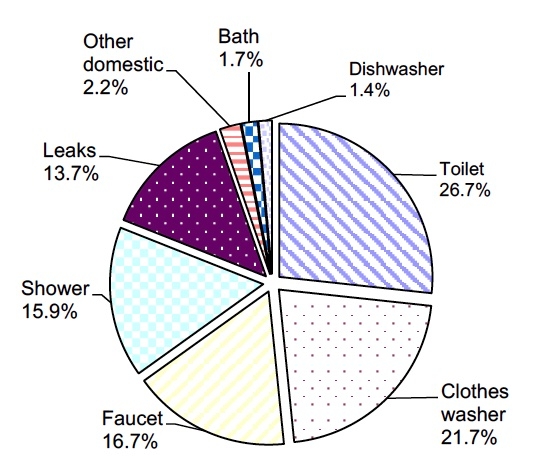Greywater Reuse
ID
BSE-114NP (BSE-267NP)
What is Greywater?
Greywater is any household wastewater other than that used for toilet flushing. This water could be reused around the home (for purposes other than drinking water). An example of greywater use is landscape irrigation. Wastewater that comes in contact with human waste is referred to as blackwater. However, the definition of greywater varies according to state regulations. In many states, greywater is defined as household wastewater from baths, showers, laundry washing, and lavatory sinks. However, greywater does not include wastewater from kitchen sinks, dishwashers, and toilets. Kitchen sink and dishwasher wastewater is often classified as blackwater because it may contain higher levels of organic materials (such as food waste) compared to greywater sources. The high organic content of these blackwater sources can lead to low oxygen content and greater microbial activity, and thus may require more stringent treatment. Additionally, if laundry water is used for diaper washing it is usually classified as blackwater rather than greywater since it has come in contact with human waste.
Why Reuse Greywater?
The average per capita use of indoor water in the US is 69.3 gallons per day (Mayer et al. 1999). Shower, bathtub, sink, and laundry water comprise approximately 50-60% of residential indoor water use, while toilet flushing uses approximately 25% (Figure 1).Outdoor water use can be the largest fraction of residential water, comprising 50-60% of total household (indoor + outdoor) water use in many locations (Mayer et al., 1999). Using greywater for landscape irrigation and toilet flushing can significantly reduce overall household water use and reduce the volume of household wastewater sent to septic tanks and treatment plants. Reusing greywater reduces the use of potable water.

How Can Greywater be Used?
Greywater use regulation varies from state to state. Some states have developed comprehensive regulations and guidelines, while others allow systems to be installed on a case-by-case basis but do not define specific guidelines or legal parameters for approval. Currently, more arid states such as Arizona, New Mexico, California, and Texas have the most comprehensive greywater reuse regulations and guidelines. State regulations designate acceptable greywater uses; the most common being toilet flushing and landscape irrigation.
Greywater systems can range from simple to complex. The most straightforward, which is illegal in many states, is direct drainage of water from clothes washers to the landscape. The most complex can involve a comprehensive storage and treatment systems that have a separate plumbing network. When stored, greywater filtration or treatment may be required to reduce pathogen growth. Many state regulations limit the storage time for greywater in reservoirs to prevent bacteria and human pathogen growth. Usually greywater distribution pipes and reservoirs must be clearly identified as containing non-potable water, and in many states the water itself may be required to be colored with a food- grade dye before entering the plumbing system. States that permit greywater use for irrigation require that subsurface irrigation systems be used to reduce human exposure to pathogens, and limit its use to non-edible landscape plants. Spray or drip irrigation of greywater is not allowed in some states, since these systems result in more direct human contact with the greywater compared to subsurface systems.
Potential Barriers to Greywater Reuse
There are several barriers that may impede the adoption of residential greywater reuse.
These include:
- System cost
- Knowledge and experience of contractors and local officials
- Sufficient and consistent codes
- Homeowner acceptance
Depending on the complexity of a desired greywater reuse system, the cost of retrofitting an existing home with separate plumbing, storage, and treatment may be perceived as too expensive, depending on the current regional cost of tap water and the availability of retrofitting incentives. The ease with which a legal, properly designed greywater system can be installed in a given location may be a major factor in homeowner or builder choice. If codes are vague or contradictory, or if permitting staff and contractors do not have knowledge and experience with greywater systems, the process of installing and permitting can be difficult.
Last, but possibly most important to the adoption of greywater reuse, is homeowner acceptance. The willingness of homeowners to incur the expense associated with maintenance or installation of greywater systems is central to widespread voluntary adoption. Certain requirements, such as requiring subsurface irrigation systems as opposed to surface drip systems, can discourage the average homeowner from adopting such a system.
References
Mayer, P.W., W.B. DeOreo, E.M. Opitz, J.C. Kiefer, W.Y. Davis, B. Dziegielewski, and J.O. Nelson. 1999. Residential End Uses of Water. American Water Works Research Foundation. 310 pp. Denver, CO
DISCLAIMER – This document is intended to give the reader only general factual information current at the time of publication. It is not a substitute for professional advice and should not be used for guidance or decisions related to a specific design or construction project. This document is not intended to reflect the opinion of any of the entities, agencies or organizations identified in the materials and, if any opinions appear, are those of the individual author and should not be relied upon in any event. Updated June 2019.
Virginia Cooperative Extension materials are available for public use, reprint, or citation without further permission, provided the use includes credit to the author and to Virginia Cooperative Extension, Virginia Tech, and Virginia State University.
Virginia Cooperative Extension is a partnership of Virginia Tech, Virginia State University, the U.S. Department of Agriculture (USDA), and local governments, and is an equal opportunity employer. For the full non-discrimination statement, please visit ext.vt.edu/accessibility.
Publication Date
January 6, 2025



